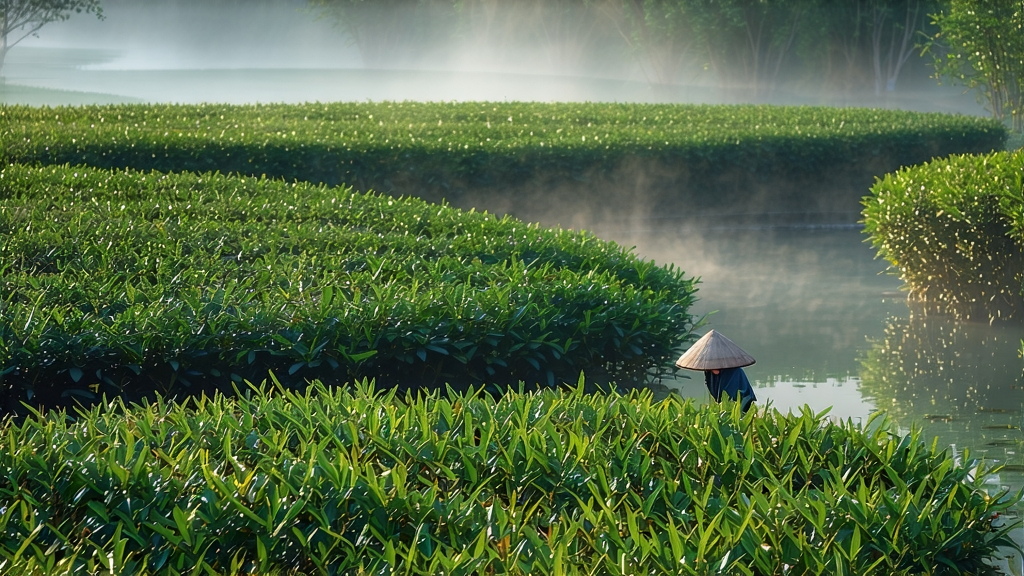
Longjing, literally “Dragon-Well,” is more than a tea; it is a liquid postcard from the hills that cradle Hangzhou’s West Lake, a sip that has greeted Chinese emperors, poets, and now a new generation of global tea lovers. First recorded in the Tang dynasty (618-907), the tea gained imperial patronage during the Qing when the Qianlong Emperor, while visiting the Hugong Temple, was so enchanted by the bushes outside the temple gate that he bestowed upon them the highest rank. The eighteen plants he personally plucked are still preserved today, fenced yet flourishing, a living monument to tea history.
What makes Longjing a green tea yet sets it apart is the cultivar and the microclimate. The core region, Xihu (West Lake), is divided into five sub-zones—Shi Feng, Mei Jia Wu, Weng Jia Shan, Tiger Spring, and Lingyin—each offering subtle variations in flavor. Shi Feng, with its mineral-rich shale soil and morning mist, yields the most sought-after profile: a gentle, almost creamy chestnut sweetness with a hint of azalea. Outside the lake district, Qiantang and Yuezhou counties produce good everyday grades, but connoisseurs chase the “pre-Qingming” pick, the first tender buds plucked before the early-April festival when the leaf contains the highest concentration of amino acids, especially L-theanine, responsible for the tea’s famous “umami-sweet” balance.
Processing begins within minutes of plucking. The leaves are spread in thin layers on bamboo trays to lose surface moisture, then hand-tossed in woks heated to 80-100 °C. A master “tea killer” (sha qing) uses only his bare hands, pressing, shaking, and stroking the leaf for twelve to fifteen minutes. The motion is choreographed: first a firm press to halt oxidation, then a light flick to roll the leaf without breaking it, ending with a flattening gesture that gives Longjing its signature sword-shaped leaf. The temperature is lowered in three precise steps so that the leaf dries but does not bake, locking in the jade-green color and locking out the grassy bitterness that mars lesser green teas. When done correctly, the finished tea contains 4–5 % moisture and will keep its aroma for eighteen months if stored cool, dark, and airtight.
To brew Longjing authentically, begin with still spring water brought to 80 °C; hotter water extracts tannins and dulls the fragrance. Use a tall glass or a gaiwan; glass allows you to watch the “tea dance” as the leaves stand upright, then slowly sink like tiny jade flags. A ratio of 3 g leaf to 150 ml water is standard. Awaken the leaves with a quick 30-second rinse, discard, then infuse for sixty seconds. Subsequent steeps lengthen by fifteen seconds. A premium grade will deliver four clean infusions: the first bright and nutty, the second lush and floral, the third minerally, the fourth a whisper of sweet water. Unlike oolong or puerh, Longjing does not reward marathon steeping; its elegance is in restraint.
Tasting follows three steps: sight, scent, and sip. Observe the dry leaf: uniform flat strips, pea-green with a matte finish, no broken crumbs. Inhale the “dry aroma” from the warmed gaiwan—freshly roasted chestnuts and faint magnolia. After the first infusion, lift the lid and breathe; the “wet aroma” should echo steamed edamame and rain-soaked granite. On the palate, seek a silky entry, a mid-palate burst of sweet corn and lima bean, and a finish that lingers like cool spring water. A tell-tale sign of top-grade Shi Feng is a slight cooling menthol at the back of the throat, a sensation Chinese tasters call “ginger flower coolness.”
Longjing also invites culinary play. In Hangzhou restaurants, chefs scatter the tender first-flush leaf over river shrimp stir-fried in cloud-like egg white; the residual heat releases the tea’s aroma without bitterness. A modern twist is Longjing-smoked duck: tea leaves and sugar are burned in a wok under a rack of duck breast, imparting a subtle toasted note. For the home bar, cold-infuse 5 g of tea in 250 ml gin for two hours, strain, and shake with lemon